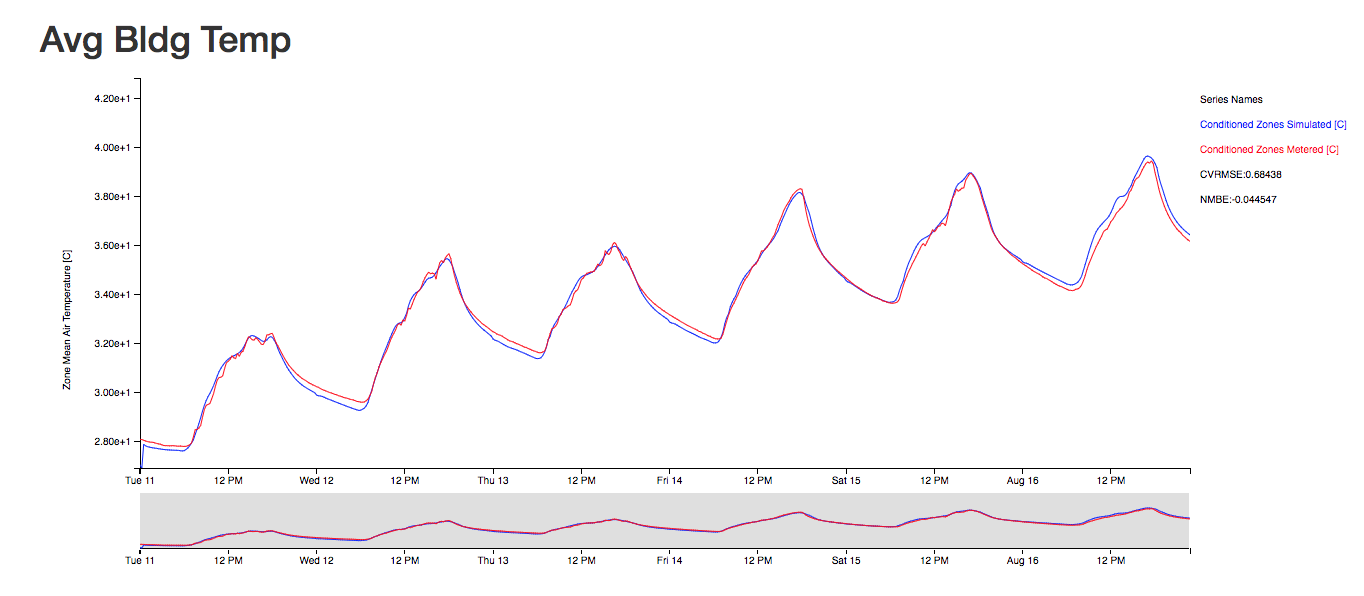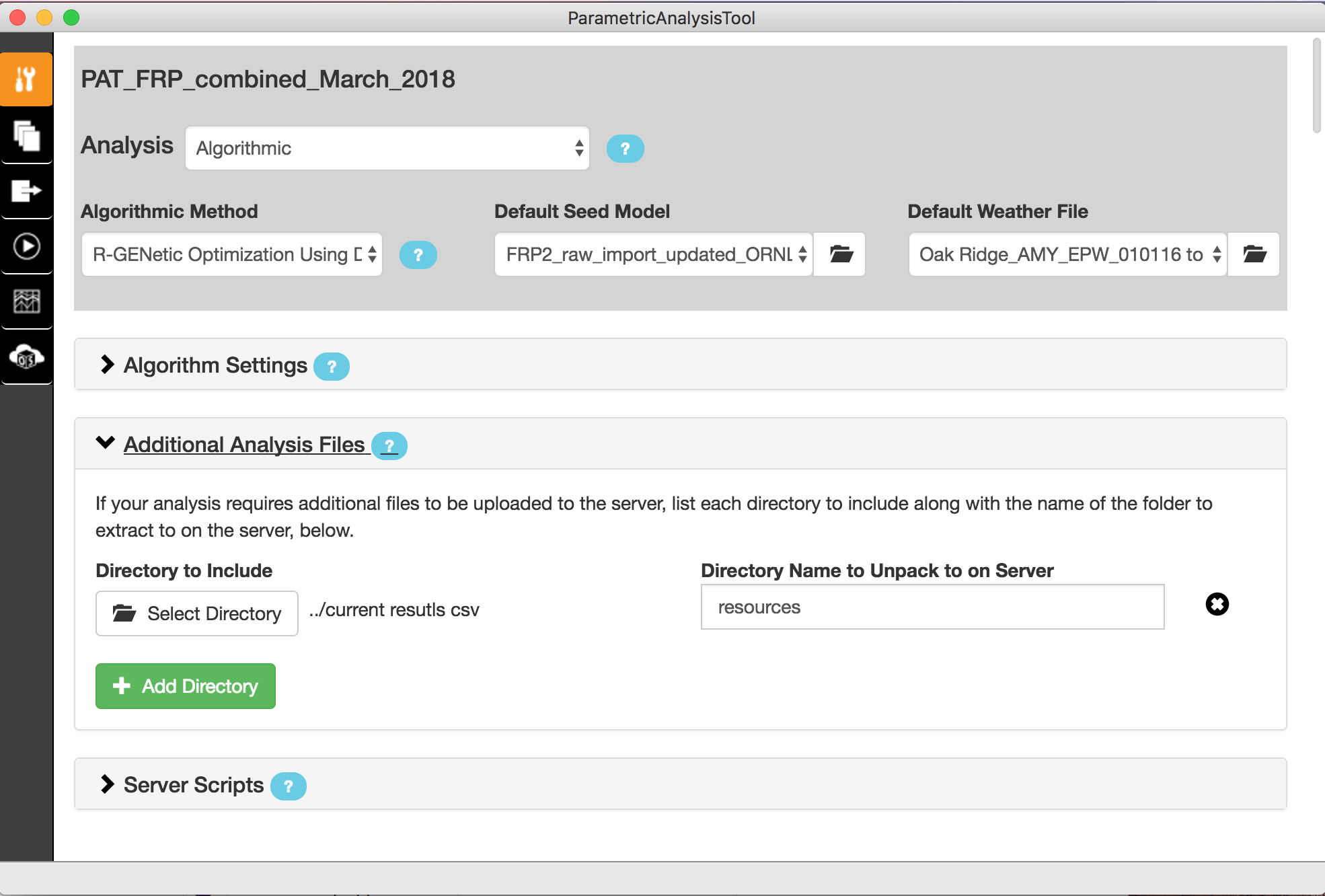 | 1 | initial version |
@rtsuchiya I'll be speaking about Time Series Calibration with OpenStudio at the SimBuild conference next week in Chicago.
I don't think I have the paper posted anywhere yet, but one of the measures we used, TimeSeries Objective Function, is on BCL and will create CVRMSE and NMBE values by comparing time series modeled SQL data against time series CSV measured data. It is setup to work for one or multiple run periods. You can just run this with LHS or some other sampling method and pick the best datapoint, or setup objectives function in PAT using the CVRMSE and/OR NMBE and choose an optimization algorithm.
The measure is setup to map an EnergyPlus output variable to a single column in the measured data. You could grab temperatures for all of the individual zones. For a free oscillation (free float) calibration created a variation on the measure to report a volume weighted average zone temperature and then created that same value in measured data. The image below is a 6 day calibration where plug loads were fixed from measured data and envelope characteristics were variables.

 | 2 | No.2 Revision |
@rtsuchiya I'll be speaking about Time Series Calibration time series calibration with OpenStudio at the SimBuild conference next week in Chicago.
I don't think I have the paper posted anywhere yet, but one of the measures we used, TimeSeries Objective Function, is on BCL and will create CVRMSE and NMBE values by comparing time series modeled SQL data against time series CSV measured data. It is setup to work for one or multiple run periods. You can just run this with LHS or some other sampling method and pick the best datapoint, or setup objectives function in PAT using the CVRMSE and/OR NMBE and choose an optimization algorithm.
The measure is setup to map an EnergyPlus output variable to a single column in the measured data. You could grab temperatures for all of the individual zones. For a free oscillation (free float) calibration created a variation on the measure to report a volume weighted average zone temperature and then created that same value in measured data. The image below is a 6 day calibration where plug loads were fixed from measured data and envelope characteristics were variables.

 | 3 | No.3 Revision |
@rtsuchiya I'll be speaking about time series calibration with OpenStudio at the SimBuild conference next week in Chicago.
I don't think I have the paper posted anywhere yet, but one of the measures we used, TimeSeries Objective Function, is on BCL and will create CVRMSE and NMBE values by comparing time series modeled SQL data against time series CSV measured data. It is setup to work for one or multiple run periods. You can just run this with LHS or some other sampling method and pick the best datapoint, or you can setup objectives function in PAT using the CVRMSE and/OR and/or NMBE values and choose an optimization algorithm.
The measure is setup to map an EnergyPlus output variable to a single column in the measured data. You could grab temperatures for all of the individual zones. For a free oscillation (free float) calibration created a variation on the measure to report a volume weighted average zone temperature and then created that same value in measured data. The image below is a 6 day calibration where plug loads were fixed from measured data and envelope characteristics were variables.

 | 4 | No.4 Revision |
@rtsuchiya I'll be speaking about time series calibration with OpenStudio at the SimBuild conference next week in Chicago.
I don't think I have the paper posted anywhere yet, but one of the measures we used, TimeSeries Objective Function, is on BCL and will create CVRMSE and NMBE values by comparing time series modeled SQL data against time series CSV measured data. It is setup to work for one or multiple run periods. You can just run this with LHS or some other sampling method and pick the best datapoint, or you can setup objectives function in PAT using the CVRMSE and/or NMBE values and choose an optimization algorithm.
The measure is setup to map an EnergyPlus output variable to a single column in the measured data. You could grab temperatures for all of the individual zones. For a free oscillation (free float) calibration I created a variation on the measure to report a volume weighted average zone temperature and then created that same value data in measured data. The image below is a 6 day calibration where plug loads were fixed from measured data and envelope characteristics were variables.

 | 5 | No.5 Revision |
@rtsuchiya I'll be speaking about time series calibration with OpenStudio at the SimBuild conference next week in Chicago.
I don't think I have the paper posted anywhere yet, but one of the measures we used, TimeSeries Objective Function, is on BCL and will create CVRMSE and NMBE values by comparing time series modeled SQL data against time series CSV measured data. It is setup to work for one or multiple run periods. You can just run this with LHS or some other sampling method and pick the best datapoint, or you can setup objectives function in PAT using the CVRMSE and/or NMBE values and choose an optimization algorithm.
The measure is setup to map an EnergyPlus output variable to a single column in the measured data. You could grab temperatures for all of the individual zones. For a free oscillation (free float) calibration I created a variation on the measure to report a volume weighted average zone temperature and then created that same data in measured data. The image below is a 6 day calibration where plug loads were fixed from measured data and envelope characteristics were variables.

Updated to show setup of CSV file in PAT:
../../../lib/resources/your_data.csv. We plant to enhance PAT so no path is needed and just a file name would be entered, but for now you need a relative or absolute path.
